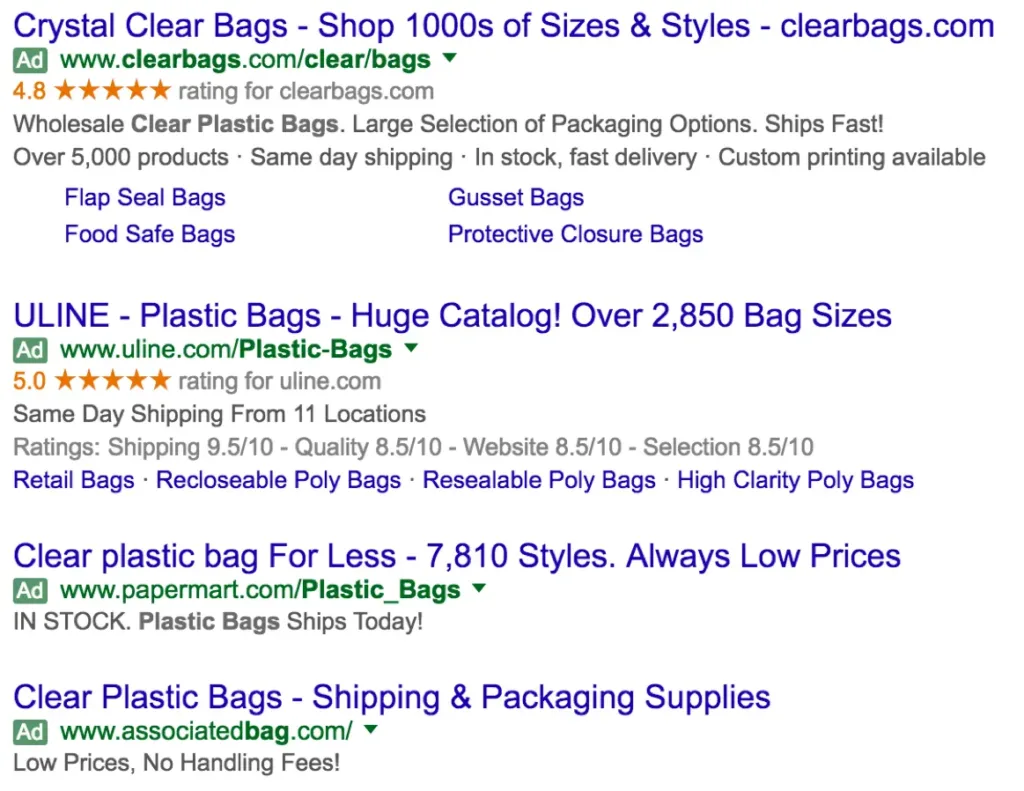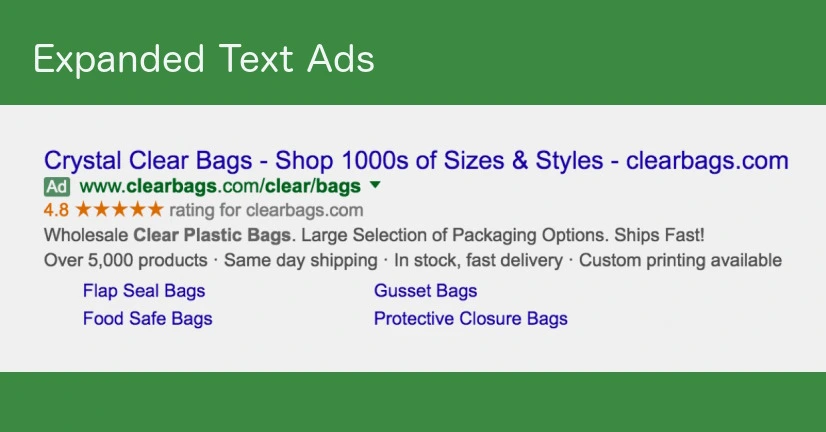About a week ago, Google rolled out a new ad format for all AdWords advertisers called Expanded Text Ads. This rollout presents some tremendous opportunities for those who act quickly, and will penalize businesses that lag behind in the coming months.
We participated in an early rollout of Expanded Text Ads during the beta period, before this new feature was released to the general public, and want to make the case for why you should act quickly to take advantage of a window of opportunity that doesn’t come along every day.
What Are Expanded Text Ads?
Expanded Text Ads are a modification of the existing ad format in AdWords, which is now being re-labeled as “Standard Text Ads”. Although similar to Standard ads in many ways, there are quite a few differences between Standard and Expanded ads. Some of these changes have to do with the display URL, and giving a more authentic experience to the user by ensuring the actual website address is in the displayed URL. But the most important feature is what gives these ads their moniker “Expanded”.
Expanded Text Ads are approximately 50% longer.
Standard ads have:
- One 25-character headline
- Two 35-character description lines
Expanded ads change that paradigm a bit by giving you:
- Two 30-character headlines
- One 80-character description
Viewed on the screen, Expanded Text Ads are much larger, command more attention, and garner more clicks.
How Much Does CTR Improve?
In our initial testing with one business during the beta program, implementing Expanded Text Ads improved the Click Through Rate (CTR) dramatically. We were actually very surprised at the results.
After implementing an initial Expanded Text Ad in every ad group, which was shown about a quarter of the time (the rest of the time, Standard Text Ads were shown by Google), we saw a CTR lift of 268% from the Expanded ads. Wow!
Three Important Caveats:
First, this was in the beta period. Most competitors had not yet implemented these Expanded ads. Once most competitors implement them, we don’t expect Expanded ads to dominate the display compared to other companies running smaller ads, so these results are probably a short-term advantage that will decline every month.
Second, we have no idea how Google decided when to display Expanded ads versus Standards ads. Perhaps they have some secret knowledge about when clicks are more likely to convert and showed the Expanded ads more frequently in this case? Or perhaps they showed the Expanded ads more frequently when they were in the #1 ad slot, to keep the visual aesthetics of the search engine result page consistent (larger more dominant ads on top), and thus these results are wildly skewed. There’s no way to know. But we certainly do know that this is not a statistically valid A/B test. Many variables could confound this data.
Finally, we noticed another effect in addition to the increase in CTR. Conversion Rate dropped. It dropped by a fairly significant 27% for people who clicked on the Expanded Text Ads. That seems alarming. But it’s also logical. Expanded ads dominate the display and garner more clicks. They’re likely to garner a disproportionate number of inappropriate clicks from people quickly scanning a search engine result page. What really matters is the net impact of the increased CTR multiplied by the decreased Conversion Rate. In this case, an increase of 268% in CTR far outweighs a decline of 27% in Conversion Rate, so we’re not worried. But it is important to notice this impact since it could potentially affect profitable bid rates throughout an account.
Logically, a more dominant ad should make CTR increase, but the impact on CTR and AOV shouldn’t be major. And that’s what we’ve seen in our initial data.
Expanded Text Ads Dominate
If you understand how Google runs ad auctions, and how AdRank is determined from the bid and Quality Score, then you also know that CTR is the main factor in determining your Quality Score. Anything that improves your CTR while leaving your Conversion Rate and AOV intact (or mostly intact) will increase your profits by making your ads show higher on the search results page, or by reducing your costs. In this battle, every percentage point matters.
Let’s take a look at what happens when you have Expanded Text Ads set up and your competitors don’t, which is the norm right now (as of August 2016).

Notice that the ad in the #1 slot has reviews, callout extensions, and sitelinks, in addition to having the only Expanded Text Ad in the list. While the ad in the #2 slot still looks good, even though it’s not an Expanded Text Ad, the ads in the #3 and #4 slots look very weak in comparison. The #1 ad is going to dominate and get the majority of the clicks, while the ads in #3 and #4 will get very few clicks in comparison.
Google’s Deployment Plans
Expanded Text Ads are available on all accounts now. Expanded ads can run alongside the older Standard ads indefinitely. There is no stated deadline for when you must implement Expanded ads. However, Google has stated that starting October 26, 2016, you will no longer be able to create Standard Text Ads. After that date, the ones you have set up will continue to run, but you will only be able to create Expanded ads going forward.
Consider what this means. Your competitors that are less nimble will probably not rush to create new ads. Many of them may not even be aware of this change yet. When October 26th hits, they’ll add Expanded ads when they create new ads, and start to see their benefits. But many advertisers will continue running the bulk of their campaigns on older Standard ads for a considerable period of time. During this time, they will see slow and steady declines in their CTR and Quality Scores relative to smarter, more nimble competitors like you.
As more advertisers start to roll out Expanded ads, your ads won’t be the biggest and dominate the screen. That will become the new norm for ad size. Expanded ads probably won’t have an impact on CTR once everyone has them deployed. You certainly won’t get the kinds of CTR lift we’re seeing today from them. But for advertisers who haven’t made the move, the lack of Expanded ads will become a stiff penalty.
The Opportunity
Pay attention now. There is a huge opportunity here. You have a window where many advertisers will lag behind, and you can move quickly to roll out Expanded ads and get some CTR benefits. You can get a big lift in your CTR by rolling them out across your account today. That lift will probably slowly degrade as your competitors jump on the bandwagon. So you have to do this now. You have to implement these ads across your entire account. And you need to start A/B testing what works and what doesn’t in this larger format so even when your competitors implement them, you still have the advantage.
There is no real cost to doing this. You will have to do it eventually one way or the other. Given that, it’s better to do it NOW, and get the benefits while the benefits are disproportionately high.
Best Practices
In some ways, it’s impossible to give advice on best practices, since this is a new system and nobody really knows yet. But there has been a beta period where some advertisers started to gain experience in Expanded Text Ads, and we can learn from them.
You should definitely read Google’s Guide to Expanded Text Ads to get the basics down, so you understand a couple of the key changes to text fields and the display URL fields. Start there.
Creating New Ads
With longer fields, you have more opportunity to communicate key benefits and include keyword text that will make your ad stand out when it is shown in bold for particular searches. But it can also be a bit of a challenge to fill that space when you’re used to writing short, terse text. You have to be more creative to fill that space well, and you do want to fill the space in order to make your ad dominate the screen and look more impressive compared to smaller ads. Don’t just copy and paste your previous text into the new fields without using them to the fullest.
To get started, sort your search ad groups by how much money they’re generating for you, and then start at the top. Go down one at a time and create a single Expanded ad. When creating your new ad, base it on the messaging and benefits that are articulated in your current top-performing Standard Text Ad.
A/B Testing
Most advertisers engage in A/B testing with two or more ads in every ad group. But don’t do this at first. You’ll get a lot of benefit by just having a single good Expanded Text Ad in each ad group. You can go back later and make a second one for A/B testing.
After you’ve created a single Expanded ad for each ad group, go back to create another one so you can start A/B testing. Depending on how much traffic your account gets, you might want to delay just a bit here to let your first Expanded ad build up more statistics before diluting those with a second. Why? Because you want to compare that first Expanded ad against the previous Standard ads and get enough data to know if you feel comfortable turning off any of your previous Standard ads. Remember, you can leave them in there indefinitely if they are top performers. But if your new Expanded ad pulls ahead quickly, it makes sense to funnel all the traffic there and to turn off the older ads once you are sure of that. There is no one right answer here, since it will vary considerably from one ad group to another and is highly dependent on traffic volume.
Headlines Can Be Cut Off
There are some situations where Google may cut off part of the second headline, if the ad needs to fit in a smaller space. In this situation, some portion of the headline will not appear, and instead it will trail off with three periods… Google has said that if that is a potential legal or regulatory issue for your business, you should ensure that what you need to communicate in your headline fits into the first 33 characters of your combined headlines. This likely isn’t a huge issue for most ecommerce firms, but it’s something to be aware of. If you can fit the key message in the first headline field, that may be your best choice.
What You Should Do Today
Bottom line… You need to take action now:
- Sort all your ad groups by how profitable they are for you
- Create one Expanded Text Ad for each ad group based on your previous top performer
- Then go back and create another one so you can start A/B testing ads
- When you have Expanded ads that are clear winners, pause lower performing Standard ads
Do it now and gain whatever advantage you can in the short run.
